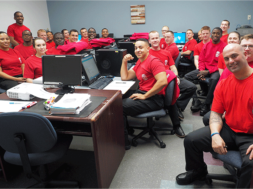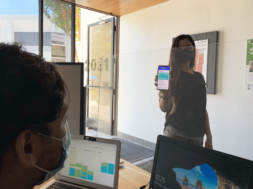
Hire – Train – Monitor – Motivate
By David J. Waldron, Author, A Great Place to Learn & Earn
This article is adapted from the book, “A Great Place to Learn & Earn: An Organizational Effectiveness Model for Career Sector Education’s Critical Role in Twenty-First Century Workforce Development,” (Country View: 2015), David J. Waldron’s professional memoir from twenty-one years of service as an award-winning campus president and director of admissions at several for-profit career schools and colleges. Both the paperback and eBook editions are available at Amazon.com. Reprinted with permission.
Student-centered, team focused, and consensus-driven organizations in career sector education, share a commitment to excellence in the recruitment and retention of faculty and staff that teach and serve its students. The unending responsibility is to hire, train, monitor, and motivate passionate employees focused on desired student, campus, and company outcomes.
I was fortunate to serve successful tenures as director of admissions and campus president by learning and practicing the art of hiring, training, monitoring, and motivating. These four skills are necessary, in unison, to build and maintain a campus or company of distinction.
Hire for attitude
As discussed in the book’s second and third chapters, People Before Vision and Campus of Distinction, hiring the best talent possible is paramount to a successful organization. But this productive method of recruiting is counterintuitive to the conventional approach of focusing on qualifications and technical skills, a challenge in the credential-obsessed education field in general.
The key is to expand your search beyond the required checks and balances of matching candidates to accreditation or corporate human resource requirements. Hire qualified individuals with optimistic mindsets and you will build a team of greatness. Positive attitudes supply the needed fuel to winning teams.
Consider a different approach to group interviews. Turn the tables and first present your campus or company and its employment opportunity in a professional, entertaining format. Then allow your guests to sneak out of the building during a scheduled break if he or she determines the job or culture is not suitable. No hard feelings as you let everyone know in your opening statement that it is okay to exit with grace, as the campus or company wishes everyone great success in his or her future career endeavors. For candidates who choose to return from the intermission, rest assured you have his or her attention.
Now have each participant share with the entire group why he or she is the best candidate for the job opportunity presented and therefore deserves a scheduled formal interview. Then ask each candidate to vote for his or her choice in anonymity, it cannot be him or her, including a brief narrative on why. You will be amazed by the results.
I have hired some of my best employees from group interviews. The cream rises to the top. The winners are often spotted at the starting gate.
Alternatively, use the same presentation and approach in the one on one interview, granting the candidate permission to end the interview at any time if the opportunity is not as envisioned. If choosing to remain, as most will in the individual meeting format, have the interviewee explain at the close why he or she is the best fit for the job. Invite back those who impress for a second, more formal interview.
Once hired, the most dedicated employees will sometimes submit a letter of resignation because a once in a lifetime opportunity found him or her that you were unable to match; or perhaps there is an unexpected spouse or partner relocation. Surprises such as these are why you need to be interviewing daily, regardless of openings. Or put another memorable way: maintain blue suits in the lobby.
Train for quality
I have found a universal response on employee surveys is the perceived need for additional training. We are creatures of learning and therefore have a perennial openness to further instruction, regardless of the level already offered. Therefore, whether a facilitator or a learner, it is important to remain in perpetual training mode.
But any employee training program in career sector education needs to focus on accreditation and regulatory requirements, and individual and team performance toward expected student and institutional outcomes.
Group training sessions can be fun and productive for the education, financial aid, and business departments. Admissions and career services teams enjoy group enlightenment as well, although salespeople are susceptible to picking up bad habits in group learning paradigms. Therefore, it is recommended that admissions and career services personnel be limited to one on one training sessions with his or her supervisor.
Regardless, train for quality performance. Time constraints aside, learning opportunities are great vehicles for communicating goals and measuring outcomes that individuals and teams have committed to achieving; as well as an excellent opportunity to praise in public.
Hire quality people and training sessions will become a rewarding get-together that celebrates success. The alternative is forced learning, with employees thinking why he or she checked “more training, please” on the survey in the first place.
When employees perceive training as a celebration of effort and an opportunity to learn things unknown, gatherings become popular events that inspire performance because of it as opposed to in spite of it.
Orientations are as important for new employees as for new students. The old cliché, first impressions are lasting, endures. It is recommended to have formal full day new employee orientations with written, segued agenda including interdepartmental participation. Once the new employee completes the required human resources paperwork, set him or her on a day to remember. Include an impassioned tour of relevant information and introductions. Take him or her to lunch. At the end of the day, leave the new employee thinking, “This is the best first day of work, ever!”
Monitor for compliance
Contrary to conventional wisdom, most compliance issues in career sector education are the result of negligence and under sight, not intent. Therefore, a compliance monitoring program designed and implemented to support and protect employees will be more efficient than one presented – or perceived – as a mere defense of the company’s stock price or reputation.
Monitoring for compliance involves assisting faculty and staff in understanding and appreciating the myriad of regulations and accreditation criteria that forever loom over a career sector education campus or company. Employees often share, or think, what is not known is of most concern.
But in a culture of trust and understanding, preference is on learning what is not known. Mystery shops, corporate visits, and other forms of compliance monitoring become expected daily activities – not surprises – toward mutual achievement of a squeaky clean, ethical and vibrant workplace.
Reward adherence to compliance in public, and coach shortcomings in private. But make it part of the culture, thus eliminating the proverbial skeletons in the closet or eight hundred pound gorilla in the room.
Why do career sector education companies insist on employing campus directors of admissions and deans of education, but not local directors of compliance? Assuming the campus president is the director of compliance by default is a fiscal cop-out. And the notion of compliance as everyone’s responsibility is also doomed to failure. When everyone is in charge, no one is in charge.
To illustrate the power of a director of compliance at the campus level, I once employed a gentleman in that role after being named the president of a degree-granting career school. He earned his annual salary early on, by discovering two regulatory facts about our for-profit institution overlooked for decades.
One, the school was not subject to its then oversight by an onerous state regulatory agency whose purview was non-degree granting for-profits. And two, as a degree granting institution, we had the authority to use the word “college” in our name, considered impossible under previous corporate and campus interpretations of state legislation and regulations.
When we asked state officials why these two profound regulatory realities were not already in place, the answer was: “Because nobody ever challenged either one, no one ever asked.” After filling out some forms and recording a sworn statement, we were granted college status under the authority of the state’s higher education body that oversaw the traditional public and nonprofit colleges, including several world-renowned research universities.
Last I heard this industrious director of compliance was working at an Ivy League school. Well done and deserved.
Monitor for compliance or be open to the observation of your relevant activities. Make it a priority. Make it fun. But do it. Your institution and its stakeholders are counting on you.
Motivate for performance
Although necessary, motivating for performance is challenging in the current regulatory environment.
When the Obama administration removed the so-called twelve safe harbors of the incentive compensation clause within the Higher Education Act (HEA) in July 2011, enrollments at for-profit schools, colleges, and universities tumbled. Four years later, the sector’s student populations remained well below record pre-2011 levels.
How did the removal of the safe harbors – thus making it illegal for institutions to reward faculty and staff for the enrollment, retention, and placement of students in specific ways – put the kibosh on career sector education’s growth?
A somewhat overlooked answer is the industry became too reliant on motivating staff toward enrollment of new students, retention of active students, and placement of graduates, by way of incentives. These monetary inducements included graduation bonuses for admissions representatives, retention rewards for faculty, and placement bonuses for career services personnel.
Select employees – most often from admissions – were rewarded with dinners, elaborate trips, and other perks. Companies incentivized management with targeted annual bonus plans based on overall student and institutional outcomes.
For the most part, these plans were ethical, although inclined toward favoring new enrollment. In hindsight, career sector education companies missed the opportunity of distributing the safe harbor incentives across the outcomes spectrum of enrollment, financial aid, education, retention, receivables, and job placement.
One prominent U.S. senator, a Democrat, shared with me in a sidebar conversation, “We are not against for-profit education. We just have an issue with too much of the budget being spent on marketing and admissions.”
If any industry has painted a bull’s eye on its back, it is career sector education.
Now that the sow has been reaped, attention needs to focus on how to motivate – or be motivated – post twelve safe harbors. Here are ten best practices that ethical, high achieving department directors are implementing to keep staff inspired in the new regulatory climate:
- Lunch when the entire team wins.
- Awards ceremonies with approved plaques and trinkets.
- Fun games for fueling the competitive spirit.
- Frequent publication of privacy cleared student and institutional outcomes to sustain faculty and staff excitement about daily contributions.
- Required attendance by faculty and staff at graduation ceremonies to experience the meaning and ultimate joy of his or her work.
- Graduating students and alumni, as speakers, at the heart of the commencement agenda.
- Publish and distribute privacy cleared dean’s lists, allowing faculty and staff to congratulate the honored students.
- Schedule events outside of campus to engage with the public by promoting what you do well.
- Conduct student surveys to not only correct common denominator issues, but to share with faculty, staff, and corporate, the positive things students say about the campus and its dedicated employees.
- Remember to praise in public, and reprimand in private.
Apply these and other motivational tools to each department, including admissions, financial aid, the business office, education, career or student services, and the campus management team. The twelve safe harbors are gone, although the ability to motivate in ethical ways remains critical to sustaining the role of career sector education in twenty-first century workforce development.
Hire, train, monitor, and motivate for results
By putting people first, students, in particular, a career sector education operation will assimilate to a culture that hires employees for positive attitudes in addition to the required credentials. When there are no openings, interview blue suits to maintain bench strength.
Train for quality performance, starting with a world class new employee orientation day, keeping in mind training is an individual exercise as much as a group one. Monitor for compliance with laws, regulations, accreditation standards, and company policies in a non-threatening manner. Share a commitment to following the rules by first knowing what the rules are. Motivate for performance through prescribed efforts to acknowledge, then reinforce, employee and student strengths. And tolerate any shortcomings that are not otherwise liabilities of the institution.
By applying these and other time-tested principles with consistency, and being open to receiving them, will more often lead to prosperous and ethical outcomes.
Now recite and repeat: “hire, train, monitor, motivate.”
Copyright © 2015-16 by David J. Waldron. All rights reserved.

David Waldron is a twenty-four year veteran of the postsecondary for-profit higher education sector, and student and practitioner of organization, team, and individual effectiveness in the transformational workplace.
He is author of three books: Hire ▫ Train ▫ Monitor ▫ Motivate (Country View: May 31, 2016), The Ten Domains of Effective Goal Setting (Country View: 2016) and A Great Place to Learn & Earn (Country View: 2015). All books are available at Amazon.com.
David was founder and publisher of Edu Investor where he was as an expert source for institutional investors, management consultants, and expert networks; and is an award winning contributing writer to Seeking Alpha, the online platform for investment research.
He was previously a campus president of Lincoln Educational Services, Kaplan Higher Education, and Katharine Gibbs Schools, Inc., where David also served as a director of admissions.
David earned a Bachelor of Science degree in business studies from Stockton University and completed The Practice of Management Program at Brown University. He and his wife, Suzan, live outside Providence, Rhode Island USA.
Contact Information: David J. Waldron // Author, Contributing Writer, Expert Consultant // Rhode Island, USA // 401-230-5857 // info@davidjwaldron.com // davidjwaldron.com // Twitter – @davidjwaldron










